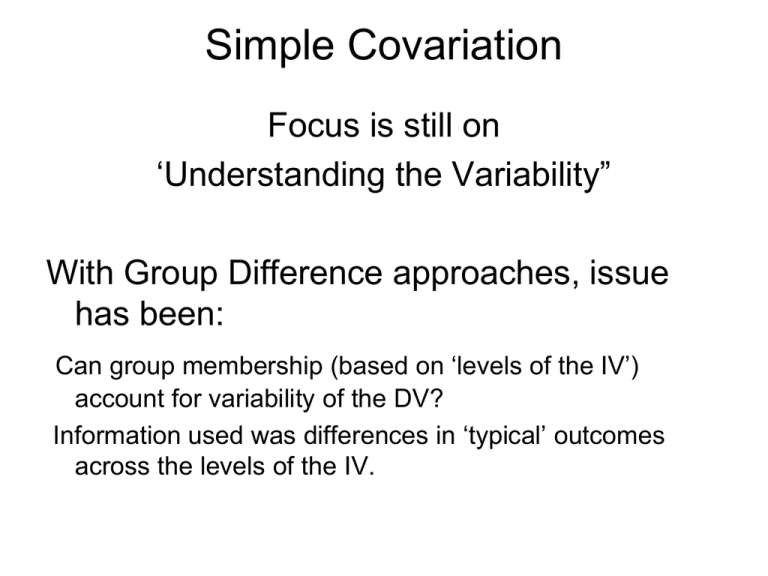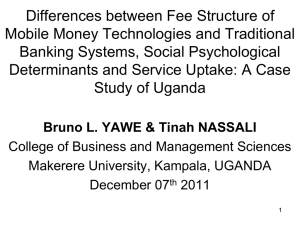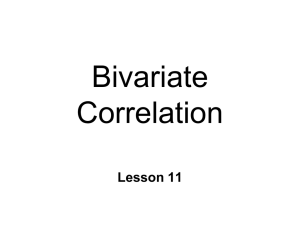Simple Covariation
advertisement

Simple Covariation Focus is still on ‘Understanding the Variability” With Group Difference approaches, issue has been: Can group membership (based on ‘levels of the IV’) account for variability of the DV? Information used was differences in ‘typical’ outcomes across the levels of the IV. Simple Covariation Did typical outcomes differ enough to suggest the presence of systematic variability? Was variability in IV associated with variability in DV to a degree unlikely to be due to ‘unsystematic’ variations? How much of the variability has been ‘explained’, and how much has not (residual) Simple Covariation Now the focus is on the degree to which pairs of variables from a common source covary. (are systematic changes in one variable associated with systematic changes in the other) No longer looking at typical performance for the group, now variability of both variables is at the individual level. If the two variables covary systematically, then knowing one variable might ‘explain’ or ‘account for’ variability of the other Simple Covariation Source of paired scores can be any type of entity: people, days, families, countries…. No longer categorize variables as IV and DV, just two variables from the same ‘source’ Seek to measure the strength of the relationship (covariation) between two variables. Simple Covariation Correlation Coefficient is an index of the relationship All of these provide an index of ‘strength’ of the relationship on a 0 – 1 ordinal scale Some also provide ‘direction’ information, when appropriate (+/-) Simple Covariation Correlation Coefficient is the index of the relationship Various forms, depending upon data Pearson’s r – two interval/ratio variables eta – one nominal, one interval/ratio variable phi or Cramer’s V – two categorical variables Spearman’s rho – two ordinal or one ordinal and one interval variable (scores converted to ranks) Not all provide meaningful direction information – but SPSS will still give sign Simple Covariation Common applications Preliminary evidence, prior to controlled experiment - If cause and Effect exists, covariation should Assess degree of association/similarity among variables – Is Cheerfulness the same as Agreeableness Is Optimism related to Risk Taking Develop prediction strategy – can SAT predict CollegeSuccess Simple Covariation Pearson’s Product Moment Coefficient (r) Index of strength and direction of a linear relationship if two variables covary in a linear relationship, then an individual’s relative position (deviations from means) on each variable should be similar Simple Covariation Pearson’s Product Moment Coefficient (r) r = covariance/‘variance’ – refresh on calculation of variance show connection to covariance r = sum (zx * zy)/df (n-1) r2 = shared variance (ratio scale) coefficient of determination Ho: r = 0, tested using a t-test with n-2 df n = # of pairs of measures Simple Covariation Examine the relationship using scatter plot Perceived Stress in the Past, and Expected Stress in the Future No stress 0 to 56 Highest stress Simple Covariation Assumptions for Pearson’s r interval/ratio data independent observations (pairs) each variable normally distributed (or not obviously not normal) linear relationship (no evidence of clear nonlinear pattern) bivariate normal distribution – (3 dimensional normal pile) homoscedasticity (similar variability of Y at values of X) Simple Covariation Limiting conditions for Pearson’s r bivariate outliers – reduces r if truly outlier on both variables truncated range – effect depends upon actual relationship (linear or nonlinear) Simple Covariation With all data Correlations Perceived Stress Last Month Perceived Stress Next Month Pearson Correlation Sig . (2-tailed) N Pearson Correlation Sig . (2-tailed) N Perceived Stress Last Month 1 Perceived Stress Next Month .738** .000 176 176 .738** 1 .000 176 176 **. Correlation is sig nificant at the 0.01 level (2-tailed). With two pairs removed Limiting conditions for Pearson’s r Correlations bivariate outliers truncated range Perceived Stress Last Month Perceived Stress Next Month If try to ‘fit’ a straight line through the scatter-plot. How would the 2 outliers impact the line? Pearson Correlation Sig . (2-tailed) N Pearson Correlation Sig . (2-tailed) N Perceived Stress Last Month 1 Perceived Stress Next Month .768** .000 174 174 .768** 1 .000 174 174 **. Correlation is sig nificant at the 0.01 level (2-tailed). Simple Covariation Typical sequence in evaluating r check assumptions calculate r When reporting r, df are number of ‘pairs’ minus 2 assess statistical significance t-test for r=0 compute r2 Coefficient of determination interpret strength and direction discuss “effect size” – shared variance Simple Covariation If you wanted to interpret all of the r’s, you would have 15 tests on the same individuals – so Type 1 will be inflated. However, you may only care about r’s for GREs with GPA Total, so only 4 r’s are relevant. As always, balance Type 1 and Type 2. Listwise – must have score on every variable Correlationsa Undergrad GPA Total Undergrad GPA Jr Sr Years GRE Verbal GRE Quantitative GRE Analytic GRE Advanced Psych Pearson Correlation Sig. (2-tailed) Pearson Correlation Sig. (2-tailed) Pearson Correlation Sig. (2-tailed) Pearson Correlation Sig. (2-tailed) Pearson Correlation Sig. (2-tailed) Pearson Correlation Sig. (2-tailed) Undergrad Undergrad GPA Jr Sr GPA Total Years 1.000 .746** . .000 .746** 1.000 .000 .129* .044 .149* .021 .229** .000 .282** .000 . .176** .006 .078 .229 .151* .018 .263** .000 GRE GRE Verbal Quantitative .129* .149* .044 .021 .176** .078 GRE Analytic .229** .000 .151* .006 .229 .018 .000 1.000 . .255** .000 .276** .000 .525** .000 .255** .000 1.000 . .527** .000 .444** .000 .276** .000 .527** .000 1.000 . .369** .000 .525** .000 .444** .000 .369** .000 1.000 . **. Correlation is significant at the 0.01 level (2-tailed). *. Correlation is significant at the 0.05 level (2-tailed). a. Listwise N=242 GRE Advanced Psych .282** .000 .263** Note sample size here, and on next page, from SAME data set! Simple Covariation Pairwise – included whenever have both scores for a coefficient N’s much lower in column for GRE Analytic – why? Correlations Undergrad GPA Total Undergrad GPA Total Undergrad GPA Jr Sr Years GRE Verbal GRE Quantitative GRE Analytic GRE Advanced Psych Pearson Correlation Sig. (2-tailed) N Pearson Correlation Sig. (2-tailed) N Pearson Correlation Sig. (2-tailed) N Pearson Correlation Sig. (2-tailed) N Pearson Correlation Sig. (2-tailed) N Pearson Correlation Sig. (2-tailed) N **. Correlation is significant at the 0.01 level (2-tailed). 1 . 393 .730** .000 371 .160** .001 393 .136** .007 393 .280** .000 296 .307** .000 348 Undergrad GPA Jr Sr Years GRE Verbal .730** .160** .000 .001 371 393 1 .171** . .001 372 372 .171** 1 .001 . 372 399 .026 .225** .615 .000 372 399 .156** .259** .009 .000 279 302 .251** .502** .000 .000 327 351 GRE Quantitative GRE Analytic .136** .280** .007 .000 393 296 .026 .156** .615 .009 372 279 .225** .259** .000 .000 399 302 1 .563** . .000 399 302 .563** 1 .000 . 302 302 .412** .377** .000 .000 351 263 N’s range from 263 to 399 using Pairwise GRE Advanced Psych .307** .000 348 .251** .000 327 .502** .000 351 .412** .000 351 .377** .000 263 1 . 351 Simple Covariation Pearson r vs. Spearman rho Correlations Ease of Return to Work Colleagues' Acceptance Customers' Acceptance Pearson Correlation Sig. (2-tailed) N Pearson Correlation Sig. (2-tailed) N Pearson Correlation Sig. (2-tailed) N Ease of Return to Colleagues' Customers' Work Acceptance Acceptance 1.000 .561** .445** . .000 .000 1216 1216 1216 .561** 1.000 .608** .000 . .000 1216 1216 1216 .445** .608** 1.000 .000 .000 . 1216 1216 1216 Difference based on whether you were willing to consider rating scale: Definitely no (1) to (9) Definitely yes to be interval or ordinal **. Correlation is significant at the 0.01 level (2-tailed). Correlations Spearman's rho Ease of Return to Work Colleagues' Acceptance Customers' Acceptance Correlation Coefficient Sig. (2-tailed) N Correlation Coefficient Sig. (2-tailed) N Correlation Coefficient Sig. (2-tailed) N **. Correlation is significant at the .01 level (2-tailed). Ease of Return to Colleagues' Customers' Work Acceptance Acceptance 1.000 .565** .445** . .000 .000 1216 1216 1216 .565** 1.000 .601** .000 . .000 1216 1216 1216 .445** .601** 1.000 .000 .000 . 1216 1216 1216 Simple Covariation Covariation and causality Conditions needed to infer Cause-Effect 1 two variables covary (covariation) 2 cause precedes the effect 3 other potential causes controlled Simple Covariation Covariation and causality Conditions needed to infer Cause-Effect 1 two variables covary (covariation) Correlation coefficients can provide a reasonable test of condition #1 Is there evidence for significant (systematic) covariation? 2 cause precedes the effect 3 other potential causes controlled Simple Covariation Covariation and causality Conditions needed to infer Cause-Effect 1 two variables covary (covariation) 2 cause precedes the effect Correlation does not directly deal with this condition – creating the… Directionality problem X Y or Y X - which of these is more likely to be true Cross-lagged strategy – provides evidence to help decide Simple Covariation Covariation and causality Cross-lagged strategy Time 1 Var X (TV violence) Var Y (Aggressive Behaviors) Simple Covariation Covariation and causality Cross-lagged strategy Time 1 Var X (TV violence) Time 2 Var X (TV violence) Var Y (Aggressive Behaviors) Var Y (Aggressive Behaviors) Simple Covariation Covariation and causality Cross-lagged strategy Time 1 Var X (TV violence) Time 2 Var X (TV violence) Y as Cause X as Cause Var Y (Aggressive Behaviors) Var Y (Aggressive Behaviors) Which direction of cause – effect receives stronger support Simple Covariation Covariation and causality Conditions needed to infer Cause-Effect 1 two variables covary (covariation) 2 cause precedes the effect 3 other potential causes controlled Because you simply select for or measure your variables, have less potential to isolate the variables of interest from other extraneous variables – creating… “Third” Variable Problem The Solution – Partial Correlation Simple Covariation Covariation and causality Partial correlation (pr) Examine correlation of X & Y after ‘removing’ variation in each that can be explained by variable Z X Y Third variable problem exists when both X and Y are related to Z, the Third variable, so the covariation of X and Y is the result of Z influencing both X and Y Z (correlation of the residuals for X and Y after removing relationship with Z) – clearer after regression Simple Covariation Correlations Investment Model Investments Rating Investment Model Investments Rating Investment Model Commitment Rating How long in months? Pearson Correlation Sig. (2-tailed) N Pearson Correlation Sig. (2-tailed) N Pearson Correlation Sig. (2-tailed) N 1 . 71 .699** .000 71 .341** .004 71 Investment Model Commitment Rating .699** .000 71 1 . 71 .349** .003 71 How long in months? .341** .004 71 .349** .003 71 1 . 71 Women in dating relationships where there had been physical abuse, were asked for rated Commitment to her partner, Time in relationship, and Perceived Investments in relationship Commitment and How long in months you have been in the relationship are correlated at +.349 **. Correlation is significant at the 0.01 level (2-tailed). Correlations Control Variables Investment Model Investments Rating Investment Model Commitment Rating How long in months? Correlation Significance (2-tailed) df Correlation Significance (2-tailed) df Investment Model Commitment Rating 1.000 . 0 .165 .171 68 How long in months? .165 .171 68 1.000 . 0 When control for Investments made to relationship, correlation reduced to +.165







